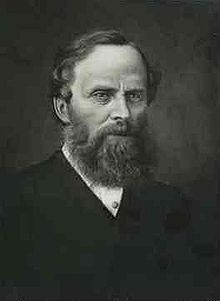- Charles Bonney
-
- For the Chicago lawyer, see Charles C. Bonney.
Charles Bonney (31 October 1813 – 15 March 1897) was a pioneer and politician in Australia.
Contents
Early life
Bonney was the youngest son of the Rev. George Bonney, a fellow of Jesus College, Cambridge, and his wife Susanna, née Knight. He was born at Sandon, near Stafford, Staffordshire, England. After his father died in 1826 his brother Thomas, headmaster of Rugeley Grammar School, gave him an education and a home for seven years.
Pioneering in Australia
Bonney left England on 5 August 1834 in the John Craig and arrived at Sydney on 12 December 1834, and became clerk to Mr Justice Burton. About 18 months later he went with Charles Ebden to the Murray River around the present site of Albury, New South Wales. In December 1836, he crossed the Murray and took cattle to Port Phillip District, having been preceded by only Gardiner and Joseph Hawdon. In March 1837 he was the first to overland sheep, bringing some 10,000 belonging to Ebden to a station on the Goulburn River. In January 1838, acting as a kind of first assistant to Joseph Hawdon, he went with him and a party with about 300 cattle, from the Murray, near Albury, to Adelaide. It was the hottest season of the year, and groups of aborigines were continually being encountered, but the party succeeded in keeping on good terms with them. On 1 March 1838 they came to the junction of the Darling River with the Murray, and the whole journey took about three months. A beautiful lake was found on 4 March and named after the young Queen Victoria, and on 12 March another lake was found and named by Hawdon after Bonney - see Lake Bonney (Riverland). They left the Murray on 23 March, and after travelling many miles, Mount Barker was reached. About 1 April they reached the seashore near where the township of Noarlunga now stands. Meeting some settlers, they made for Adelaide, where they arrived on 3 April and found a ready market for their cattle. Returning to Port Phillip by sea, Bonney brought another herd of cattle overland to Adelaide in February 1839, the route taken being through south-west Victoria. Near the border the country became very dry, and disaster was narrowly escaped. Fortunately water was found, and when the Murray was crossed only one bullock and one horse were lost. In spite of their difficulties, only 23 cattle were lost on the whole journey. Bonney stayed at Adelaide for a time and then joined Ebden again at the Murray. In 1841 a period of depression led to cattle becoming almost unsaleable.
Political career
In 1842 Bonney became a magistrate and commissioner of crown lands in South Australia. He held this position for about 15 years. When responsible government came in, Bonney was elected a member of the South Australian House of Assembly for East Torrens, and became commissioner of crown lands in the first ministry under Finniss. This ministry went out of office in August 1857 and Bonney resigned his seat in the following January. He was in England from 1858 to 1862, and returning to South Australia, was a member of the South Australian Legislative Council in 1865 and 1866. In 1861 he was elected a fellow of the Royal Geographical Society. From 1869 to 1871 he was manager of the South Australian railways. In 1871 he was appointed inspector of lands purchased on credit, and in 1880 retired on a pension. In 1885 he went to Sydney and died there on 15 March 1897. He left a widow, two sons and three daughters.
References
- H. J. Gibbney, 'Bonney, Charles (1813 - 1897)', Australian Dictionary of Biography, Volume 3, MUP, 1969, pp 188-190.
- Serle, Percival (1949). "Bonney, Charles". Dictionary of Australian Biography. Sydney: Angus and Robertson. http://gutenberg.net.au/dictbiog/0-dict-biogBe-Bo.html#bonney1.
Categories:- 1813 births
- 1897 deaths
- Explorers of South Australia
- Settlers of South Australia
- Members of the South Australian House of Assembly
- Members of the South Australian Legislative Council
Wikimedia Foundation. 2010.

